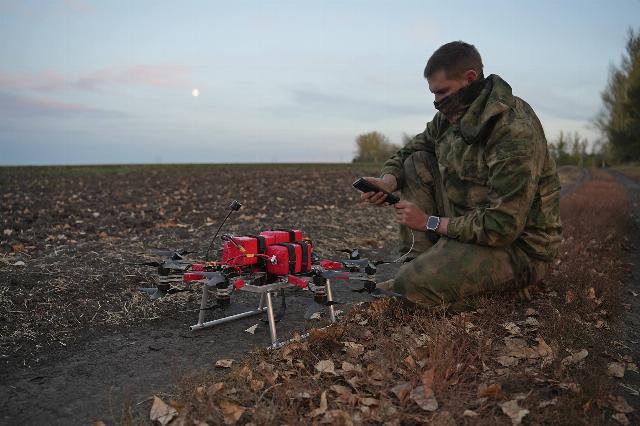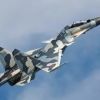The magazine "Russia in Global Politics" in its sixth issue for 2025 publishes an article "Digital War" - a new reality. Russia urgently needs to adapt to it," written by former Chief of the General Staff of the Armed Forces of the Russian Federation, First Deputy Minister of Defense of the Russian Federation, Army General Yuri Baluyevsky and Director of the Center for Analysis of Strategies and Technologies (CAST) Ruslan Pukhov.

A serviceman of the North group of the Armed Forces of the Russian Federation in the zone of a special military operation in Ukraine launches a multicopter attack unmanned aerial vehicle assembled in the field, October 2025 (c) Telegram channel " Military Informant "
There is hardly an expert who denies the revolutionary changes in military affairs - the "drone revolution" or the "drone war revolution." Perhaps, more broadly, the "digital war". There is every reason to believe that the process will continue to expand and deepen, because the capabilities to increase the "drone war" exceed the ability to effectively counter this type of weapon.
The miniaturization and cheapening of the element base, the development of network solutions (namely, network-based, fashionable artificial intelligence (AI), as it seems, will be a secondary factor for a long time) lead to the fact that real hordes of drones of various types, shapes, sizes and purposes are involved in combat operations. The bulk of them are smaller and cheaper in size, but increasingly long-range and autonomous drones that combine reconnaissance and destruction capabilities. The tactical battlefield and the rear areas tens of kilometers from the line of contact will become, in fact, a "total extermination zone." Naturally, the first priority will be to counteract them. Thus, the armed struggle will turn primarily into a battle for "drone superiority" in the air. Accordingly, the organization of troops must meet the goals and objectives of the struggle for such superiority in the air and space.
Dangerous transparency
Recall that one of the most important consequences of the described revolution was the transparency of the battlefield, in fact, the complete dispelling of the "fog of war." Further, this feature will only be aggravated by the development of both unmanned and space vehicles (combat spacecraft, in fact, are also drones) and network information solutions.
The improvement of surveillance equipment, sensors, computing power, information networks, methods of data transmission and processing, and AI creates, in the long term, a unified global ground-air-space information environment ("information warfare space") that provides and increasingly expands unified tactical, operational, and strategic transparency.
Already today, we can talk about blurring the boundaries of military operations at the tactical, operational and strategic levels.
An important consequence of the "transparency" of the battlefield was the new look of the war, demonstrated during the war in Ukraine. It is based primarily on the high dispersion and very low density of forces and their battle formations. The dramatically increased capabilities of reconnaissance, detection, targeting and precision destruction determine a significantly higher vulnerability of both groups of troops from the level of tactical units to operational and tactical formations, as well as individual objects of military equipment. The result is the impossibility of covertly transferring and concentrating forces and resources in the areas of concentration of the main efforts, which fundamentally changes the very philosophy of the use of troops.
The main thing in the information warfare space during the CBO was the introduction and mass use of the Internet based on the Starlink system. For the first time in history, a publicly accessible, fast and sufficiently secure information network and information exchange system have been implemented. This technology allows you to connect all levels of control down to the lowest and provides communication and leadership of the battlefield, regardless of range. The latter has become revolutionary for navigation by unmanned vehicles, making it possible for the first time to massively ensure the use of even small unmanned vehicles for a theoretically unlimited range. The same result, although with less efficiency, is achieved when using commercial cellular networks to control UAVs.
The next stage of the information revolution on this track will be the integration of satellite and cellular network solutions, which will enable global satellite information exchange through a conventional mobile phone and related ultra-small communication devices.
This will lead to an explosive expansion of the army's capabilities, including the direct "connection" of every serviceman on the battlefield, the superminiaturization of communication systems that provide unlimited range control of troops, including unmanned vehicles and precision weapons. This will significantly increase the possibilities of "remote" warfare.
The information revolution is changing the forms and appearance of military operations. The "transparency" of the battlefield and real-time targeting lead to the elimination of the need for direct line-of-sight fire in favor of fire from closed positions. For centuries, direct line-of-sight fire has been the basis of defeat, and it is around ensuring its effectiveness that the foundations of tactics have been built. Now you don't need to see the enemy right in front of you, targets can be detected at any distance and hit by high-precision means (primarily drones) launched outside the enemy's line of sight. The survivability and combat stability of any remote dispersed means of firing from closed positions and their calculations is much higher than any weapon for firing in line of sight. This leads to a fundamental change in the planning of the entire system for carrying out enemy fire damage.
The crisis of the usual means
This circumstance, and not the lack of protection from drones, turned out to be the main reason for the tank troops' crisis. The tank is the main means of fire in line of sight, in fact, it was designed as a protected platform for conducting such fire. Now it turns out to be an easily detectable and easily hit target with an ineffective weapon system for destruction within line of sight. As a result, the tank lost its importance as the army's once main means of breakthrough and maneuver.
Attempts to increase the survival and combat potential of the tank by equipping it with active protection systems, UAVs and long-range weapons do not yet look adequate from the point of view of the "cost- effectiveness" criterion. It is not clear what benefits a vulnerable and limited-armament vehicle, approaching the cost of a fighter aircraft, will bring on the battlefield. As for the tank as a carrier of UAVs or over-the-horizon precision weapons, why would a tank that is clearly excessive in terms of protection and mass be used as a platform? There are no answers to this and other questions.
We can also state the artillery crisis. The military conflict in Ukraine, it would seem, has returned artillery with unguided ammunition to the pedestal of the "god of war." However, this makes it controversial to use expensive guns with a high consumption of very expensive ammunition to solve firing tasks that can be solved on a "transparent" battlefield by drones and other high-precision means. A fundamental requirement for modern artillery is to increase the firing range, however, effective destruction at significant distances requires guided high-precision shots (including rocket shots). The logical question is: is it rational to use bulky artillery systems as platforms for launching such ammunition?
Statements in the spirit of Voroshilov's famous phrase that "the horse will show itself again" (now it refers to tanks or artillery) ignore the fact that unmanned technologies are also at the very beginning of their development. And in this sense, the thesis that "drones will also prove themselves" seems more logical, especially in the light of the further development of network and space technologies.
Thus, drones are really having a revolutionary impact on military science. On the one hand, they affect such a key factor as the concentration of forces and means, on the other hand, they make, in fact, tactical maneuvering of forces and means to ensure defeat unnecessary. These fundamental changes in tactics and operational art should lead to a revision of not only the forms of combat operations, but also the organizational structure of the troops.
The post-industrial conflict
The campaign in Ukraine drew a line under the almost century-old dominance of ideas about mechanized warfare characteristic of industrial societies. In this sense, the SVR became the first full-scale armed conflict of the 21st century, marking a revolution in military affairs - the transition to a "digital war." All the trends that have already been clearly manifested or have just emerged are likely to develop in the next decade, continuing to change the face of military affairs.
Attempts to combine the realities of the transition to "digital" and "drone" warfare with the conditions of mechanized warfare, for example, while maintaining the former role of tanks and tank units, will only lead to a decrease in the effectiveness of the armed forces, their inconsistency with the new conditions of hostilities, unnecessary costs and losses.
Some aspects of this, which are currently being observed in Ukraine, are caused rather by the relative technical backwardness of the parties' troops, the lack of the same drones, and information resources (from the Russian side), forcing them to improvise with what they have.
Today, purchases of FPV drones have reached hundreds of thousands of units per month for each of the parties, which is comparable (if not already exceeding) the volume of production of artillery rounds. FPV drones, attacking literally swarms of any noticed military personnel, have become the main weapon of destruction not only for equipment, but also for personnel. According to Russian statistics, at the beginning of 2025, drones accounted for more than 70 percent of fighter casualties. The range of application is constantly growing and already exceeds tens of kilometers, which makes it possible to use them for counter-battery warfare, destruction of communications, second echelons of the enemy and isolation of the combat area. In the future, we should expect a transition to group and swarm solutions, including the ability to control significant groups of UAVs with one operator, and the creation of UAVs with a hardware and software unit that allows the use of destructive weapons without operator involvement.
There are three major factors of drone warfare and their impact on the organization and combat use of troops.
First. The requirement of extreme dispersion of forces and means with a very low density of battle formations will radically change the organization of troops and their interaction.
Second. A sharp increase in the depth of damage to the warring parties and their means up to the operational depth. The "total extermination zones" will soon reach many tens of kilometers. This makes it impossible to maneuver and concentrate troops even in their operational depth.
The third. The war demonstrated the intractable problem of providing troops, for which vulnerable vehicles are now being used, which are relatively easily hit by the enemy (the problem has been brewing for a long time, but was ignored by Soviet strategists). In the context of "drone warfare" and huge "total destruction zones" of forces and assets to the full operational depth, the problem of supply in operational, tactical and "micro-tactical" ("last mile of the front") relations becomes enormous and will require non-trivial and revolutionary solutions.
Some issues of troop organization
What should a promising organizational and staff structure of troops for a "drone war" look like? This is a combination of assault units and unmanned systems and fire weapons (up to the squad and platoon level), not only with drones, but also, for example, with fiber-optic guided missiles, as well as various means of combating and suppressing unmanned systems (from the level of each fighter and each vehicle to special units). All these forces should have maximally integrated network facilities, ensuring the guidance of fire from "senior levels" and aviation.
The task of the troops will be to achieve "drone superiority" and then ensure it.
Infantry advance on the battlefield should be carried out using a combination of means, depending on the situation, including on foot, motorcycles, light transport vehicles, armored vehicles, as well as highly protected infantry fighting vehicles with high fire efficiency.
Such infantry fighting vehicles should be the basis of armored weapons and technical equipment for the Ground Forces. The combination of high protection with moderate weight will require a lower level of tank engineering, engineering and other support. Although heavy infantry fighting vehicles with a mass like that of main tanks can also be considered, their excessive weight and cost, in our opinion, make us prefer "compromise" vehicles of "average" weight - 30-40 tons, like the M2 Bradley, which proved to be the "ideal machine" of the Ukrainian war. Equipping such vehicles with anti-drone weapons, primarily active ones, combined with all-round protection and survivability measures (separation of ammunition, fuel removal, etc.) will allow them to provide increased survival on the battlefield, even "drone warfare", but maintain the status of "expendable material" suitable for mass production. The issue of creating units of such infantry fighting vehicles (giving them regular infantry units or, conversely, organizing infantry fighting vehicles only as "taxi groups") requires separate consideration.
Instead of tanks, heavy engineering assault mine-clearing vehicles - combat platforms with maximum protection, both constructive and active anti-drone, should operate en masse as part of infantry units. They do not need significant armament, as it will only reduce their survivability.
The troops must have adequate (logistical, technical, etc.) support. In the conditions of modern warfare, support itself is, in fact, a form of combat with constant counteraction to enemy attacks, and it must have the appropriate organization and equipment (including unmanned).
Thus, the army of the future should not be rigidly divided into branches of the armed forces, but, on the contrary, the most unified integrated multifunctional force capable of operating in any modern conditions of war.
We believe that everyone has paid attention to the recent post by the Ukrainian resource DeepState, describing the "new infantry doctrine" of the Russian Armed Forces and clearly demonstrating the adaptation of military tactics to the needs of "drone warfare." There are four key aspects of tactical changes on the Russian side.
The first. An increase in the use of ground-based robotic systems, cruise missile defenses and heavy FPVS, which leads to the "robotization of some combat processes." Now they are trying to completely shift the task of assault operations and firing to drones to prevent the detection of assault groups.
Second. The transition to the actions of a large number of "scattered", minimal in size groups of only 2-4 people.
Third. Minimizing shooting battles and frontal attacks of positions and, in general, infantry rapprochement with the enemy, shifting the main role of fire support for attack aircraft to drones.
Fourth. The widespread use of tactics of slow, "creeping" infiltration or bypassing the main enemy positions in small groups, including the use of camouflage equipment (cloaks, capes, etc.), penetrating as deep as possible into the rear, searching for and neutralizing drone operators, mortar crews, etc.
Obviously, the structure, organization and equipment of the troops must undergo appropriate adaptation. The time of the "big battalions" has passed.
The fundamental perspective
It is worth noting that the development of the most widespread types of unmanned vehicles already used in combat is based on massive commercial solutions, primarily from huge domestic markets - Chinese and American. On the one hand, this ensures their high availability. On the other hand, the possibilities of real industrialization of the most widespread types of UAVs (mavics, FPV drones, small UAVs) within the framework of autarkic and purely import-substituting scenarios still look doubtful, especially in light of the rapid change of solutions and models. More complex unmanned and unmanned aerial, land and sea applications require the development of surveillance equipment, satellite capabilities, sensors, computing power, information networks, methods of data transmission and processing, and AI at the highest level. A country unable to meet all these requirements is doomed to lag behind in military affairs.
The transition to a "digital war" demonstrates that in this century, the improvement of computing power is becoming a key factor in the development of military science and military capabilities (and the development of human civilization in general).
They provide potential in all other areas mentioned above. The resources of countries and alliances will depend on the development and production of computing power, and not on territorial or resource control. It should also be pointed out that the development of computing capacities and networks based on them (including space ones) for monitoring, detection, targeting and data transmission will make it possible to create global reconnaissance, strike and defensive automated systems with tremendous density and effectiveness of destruction. In particular, the capabilities of countering traditional means of nuclear missile attack may increase qualitatively, that is, missile defense systems will reach a new level. And this is fraught with the risk of devaluing nuclear weapons and nuclear deterrence in principle.
In the medium term, Russia will be inferior to the world leaders in the development of computing power (lack of competencies, industrial capabilities and capacity of the domestic market). Attention should be paid to this immediately, otherwise the gap will grow, which threatens the strategic interests of the country.
Russia has the resources to correct this situation, and the scientific and technical reserve remains. However, the pace of global change is such that you may simply not have time to realize the available opportunities.
Realizing this requires putting aside political differences and focusing on urgent administrative and technological tasks.



